A few days ago, while writing an article on optical communication, I mentioned the CE, C++, and C+L bands.
Many students asked, previously they only knew about the O band, E band, C band, and L band, and had never heard of CE, C++, and C+L bands. What do these mean?
Today, I’ll specifically explain this.
▉ Traditional Bands
As we all know, optical fiber communication uses light as the information carrier, transmitting it through the core for communication.
However, not all light is suitable for optical fiber communication. Different wavelengths of light have different transmission losses in fiber.

The core of the optical fiber – the core (quartz fiber)
To minimize losses and ensure transmission effectiveness, researchers have been working hard to find the most suitable light frequency (wavelength).
In the early 1970s, the practical application of optical fiber communication began. The main research object at that time was multimode fiber.
Multimode fiber has a larger core diameter, allowing different modes of light to transmit through a single fiber.
The first light used had a wavelength of 850nm, which is directly referred to as the 850nm band.
Later, by the late 1970s and early 1980s, single-mode fiber began to be widely applied.
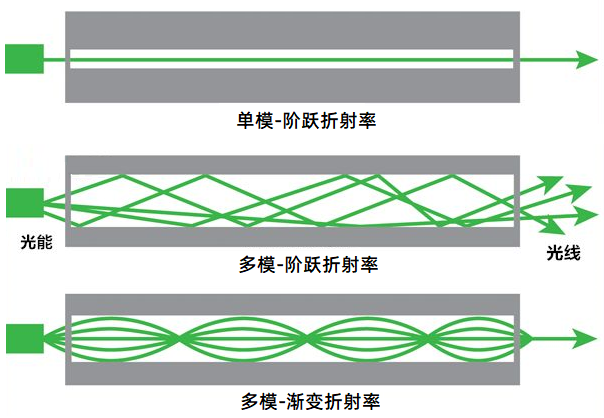
After testing, engineers found that light in the wavelength range of 1260nm to 1360nm had the least signal distortion due to dispersion and the lowest loss.
Thus, they adopted this wavelength range as the early optical communication band, naming it the O-band (O band). O stands for “Original”.
Over the following thirty to forty years, through long exploration and practice, experts gradually summarized a “low-loss wavelength region”, which is the 1260nm to 1625nm region. Light in this wavelength range is most suitable for transmission in fiber.
This region has been further divided into five bands: O band, E band, S band, C band, and L band.
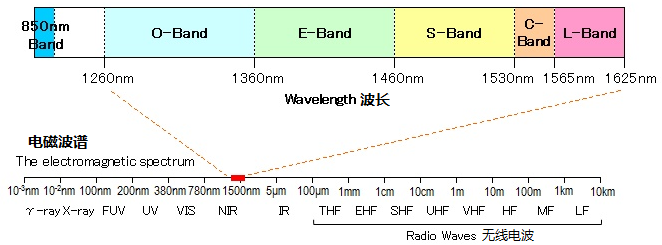
With continuous technological advancement, experts have also verified the relationship between optical fiber transmission loss and light wave wavelength, as shown in the figure below:

The most commonly used band is called the C band (1530nm~1565nm). C stands for “conventional”.
The C band exhibits the lowest loss and is widely used in metropolitan area networks, long-distance, ultra-long-distance, and submarine cable systems. The C band is also frequently used in WDM wavelength division multiplexing systems.
The band adjacent to the L band (1565nm~1625nm) has the second-lowest loss and is also one of the mainstream choices in the industry. When the C band is insufficient to meet bandwidth demands, the L band will be used as a supplement. L stands for “long-wavelength”.
S band (1460nm~1530nm), also known as the “short-wavelength” band, has higher fiber losses compared to the O band. It is often used for downstream wavelengths in PON (Passive Optical Network) systems.
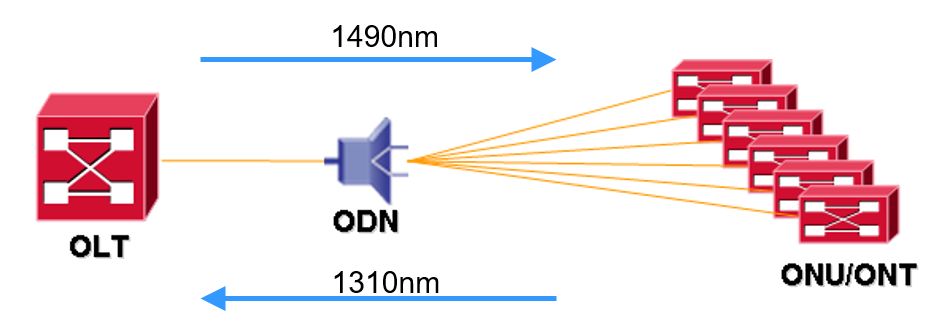
PON is the system for home fiber broadband.
Its upstream wavelength is 1310nm, and its downstream wavelength is 1490nm.
Finally, let’s look at the E band.
This band is somewhat special; it is the least common among the five bands. E stands for “extended”.
Upon observing the previous wavelength and loss relationship graph, one can see a significant irregular peak in the E band.
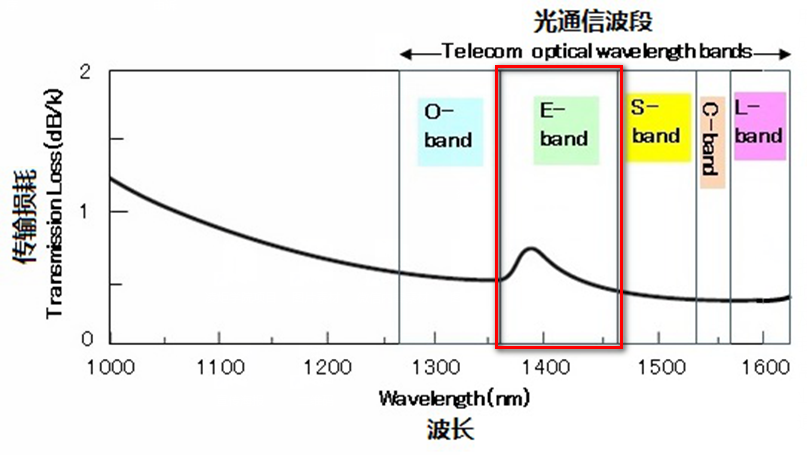
This is because in the 1370-1410nm band, hydroxyl ions (OH-) absorb, causing a sharp increase in loss. This is also referred to as the water peak.
In the early days, due to process limitations, water (OH groups) impurities often remained in the optical fiber glass, resulting in the highest attenuation in the E band, making it unusable.
Later, with the invention of dehydration technology during the glass manufacturing process, the attenuation of the most commonly used fiber in the E band (ITU-T G.652.D) became lower than that of the O band, thus resolving the water peak issue. (G.652.D is also known as low-water-peak fiber or water-peak-free fiber.)
Besides the bands mentioned above, there is actually another band that is used, which is the U band (ultra-long-wavelength band: 1625-1675 nm). The U band is mainly used for network monitoring.
To summarize, as shown in the table below:
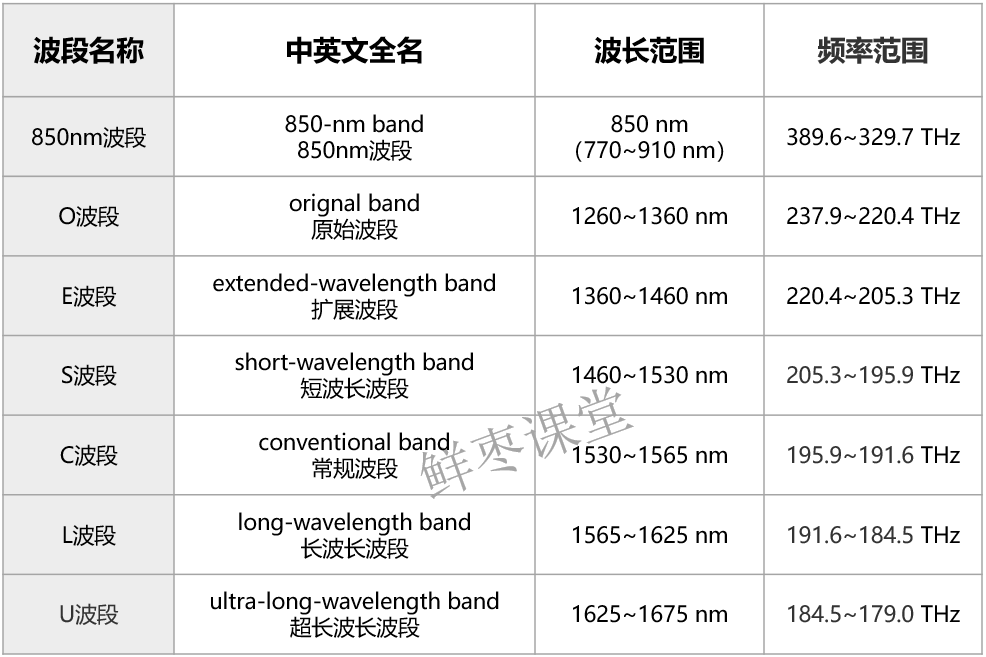
▉ Trend of Band Expansion
To this day, the situation with bands has changed again.
With the continuous growth of network data traffic, the capacity of optical fibers needs to be further expanded.
To expand capacity, there are several methods:
1. Adopt more advanced modulation methods, spectrum shaping techniques, and various multiplexing methods (polarization multiplexing, spatial multiplexing, and even angular momentum multiplexing, etc.);
2. Increase the number of cores in a single optical fiber;
3. Use a larger spectrum bandwidth to increase the number of channels.
For the third method, experts have thought of expanding the existing bands (the ones mentioned earlier).
-
CE Band
The traditional C band refers to the wavelength range from 1529.16nm to 1560.61nm, with a frequency range of 195.9THz to 191.6THz, approximately allowing a spectrum range of 4THz. At a 50GHz spacing, this traditional C band can support 80 channels, hence it is also called the C80 band.
The CE band is a slight extension of the C80 band towards longer wavelengths, with a wavelength range of 1529.16-1567.14nm, allowing a spectrum range of approximately 4.8THz. At a 50GHz spacing, the CE band can support 96 channels, hence it is also called the C96 band.
Compared to the C80 band, the C96 band can increase transmission capacity by 20%.
-
C++ Band
Now let’s look at the C++ band scheme.
Upon seeing C++, many will feel a sense of familiarity. However, this C++ has nothing to do with the C++ programming language.
C++, in fact, is a further extension based on the C96 band, with a wavelength range of 1524-1572nm, allowing a spectrum range of approximately 6THz, and the number of channels can be expanded to 120. Hence, C++ is also referred to as the C120 band (sometimes called the Super C Band).
The C++ band can increase transmission capacity by 50% compared to the C80 band.
-
C+L Band
Finally, let’s look at the C+L band scheme.
The L band ranges from 1565nm to 1625nm, and if calculated from 1570~1611nm, the usable spectrum range is approximately 4.8THz. Therefore, the C+L band can achieve 192 wavelengths, with a spectrum bandwidth close to 9.6THz, nearly doubling the transmission capacity.
To illustrate, the comparison is as follows:
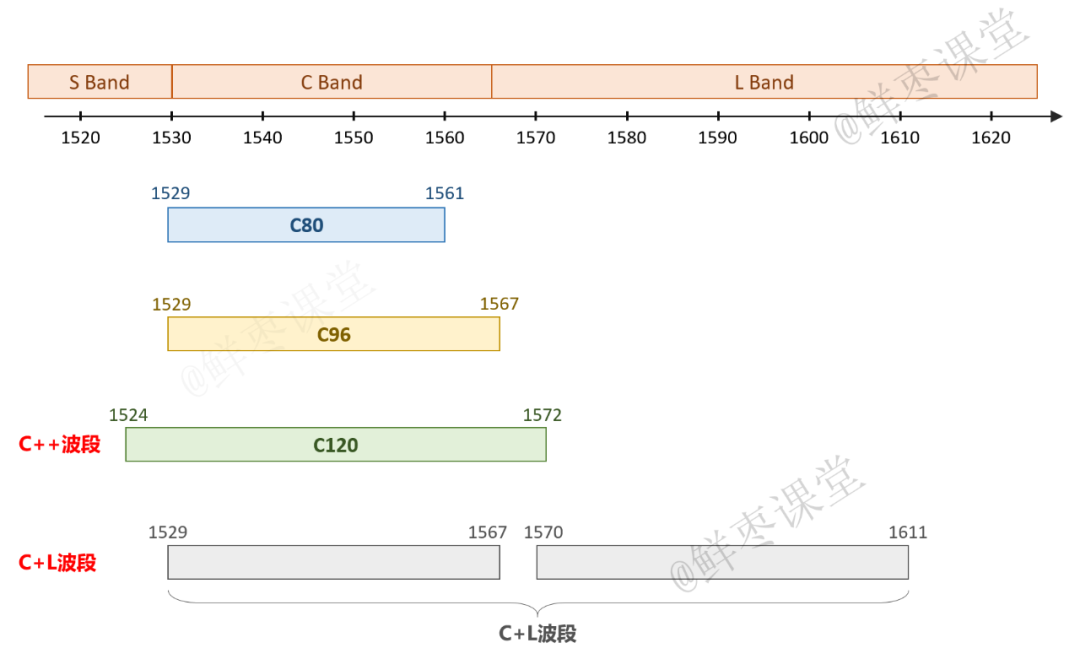
To provide a clearer comparison, here’s a table:
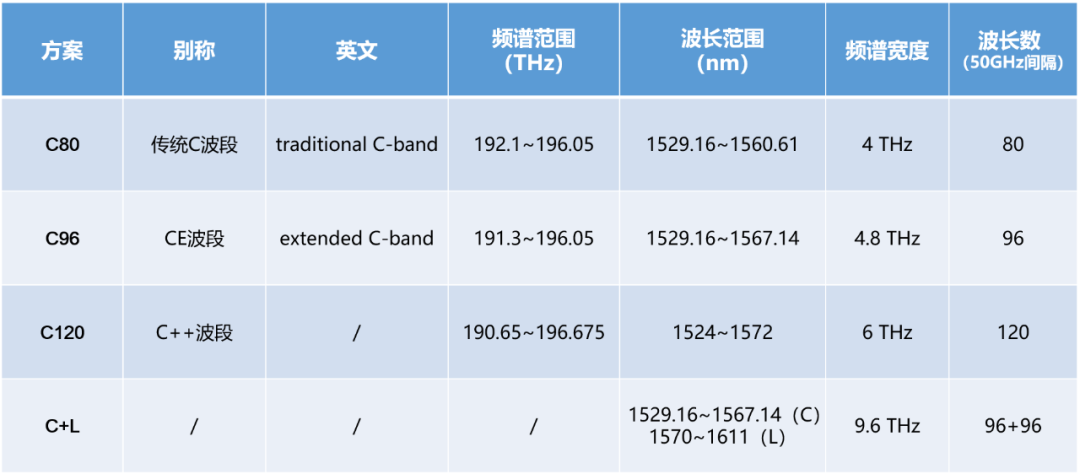
It is worth mentioning that the C+L band also has various potential schemes and spectrum boundaries, such as:
C4T+L4T: 1529~1561nm (4THz) + 1572~1606nm (4THz)
C6T+L6T: 1524~1572nm (6THz) + 1575~1626nm (6THz)
One might also notice that the L band has an L++ band, sometimes referred to as the Super L Band.
▉ Conclusion
The above is an introduction to the differences between the C, CE, C++, and C+L bands.
Overall, the available spectrum resources for optical fibers can be expanded to a very large range. However, achieving this is not so simple.
The main challenge comes from the higher requirements of optical devices for spectrum expansion.
Active devices like erbium-doped fiber amplifiers (EDFA), optical modulators, and passive devices like WSS (limited by LCOS technology) cannot all directly support the newly expanded spectrum range; upgrades are necessary. Especially for the L band, the degradation in transmission performance is worse, increasing operational complexity and subsequently raising cost investments.
On the other hand, the specific standards for spectrum expansion schemes still need further improvement and clarification.
In summary, spectrum expansion is an inevitable path, but how exactly this path should be walked still requires time to reveal the answer.
Alright, that’s all for today. Thank you for your patient reading!
—— End of Full Text ——
References:
1. “Technical White Paper on Extended C Band Wavelength Division Multiplexing Systems”
2. New Development Directions in Optical Communication, Fiber Online
3. Discussion on the Technology of Expanding C Band Wavelength Division Multiplexing Systems, China Telecom Zhang Anxu
4. Optical Line Systems: The Road to 100Tbps, Ovum
